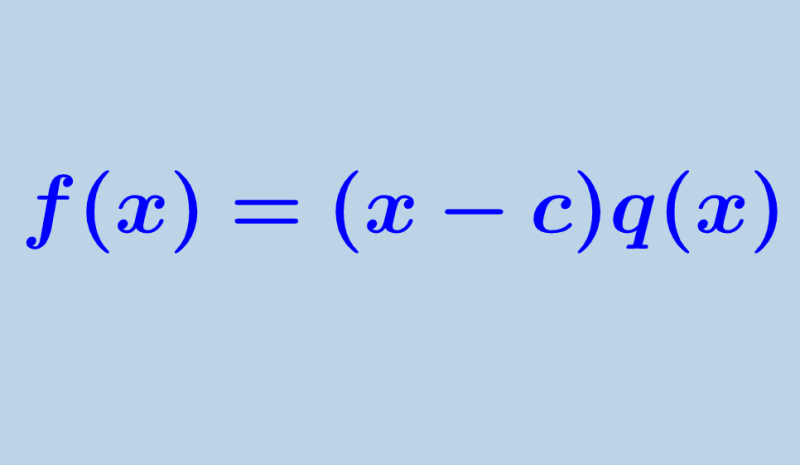The Factor Theorem is frequently used to factor a polynomial and to find its roots. The polynomial remainder theorem is an example of this. The factor theorem can be used as a polynomial factoring technique.
In this article, we will look at a demonstration of the Factor Theorem as well as examples with answers and practice problems.
Summary of the factor theorem
The factor theorem enables us to factor any polynomial by testing for different possible factors. It basically tells us that, if (x-c) is a factor of a polynomial, then we must have f(c)=0.
We can prove the factor theorem by considering that the outcome of dividing a polynomial f(x) by (x-c) is f(c)=0. Therefore, we can write:
$latex f(x)= (x-c)q(x)+f (c)$
f(x) is the target polynomial, while q(x) is the quotient polynomial.
We can use the fact that f(c)=0, to get:
$latexf(x)= (x-c)q(x)+f (c)$
$latexf(x) = (x-c)q(x)+0$
$latexf(x) = (x-c)q (x)$
As a result, (x-c) is a factor of the polynomial f(x).
The following statements apply to any polynomial f(x):
- The remainder is zero when f(x) is exactly divided by (x – c)
- (x-c) is a factor of f(x)
- c is the solution to f(x)
- c is a zero of the function f(x), or f(c) =0
Factor theorem – Examples with answers
Using the formula detailed above, we can solve various factor theorem examples. Each of the following examples has its respective detailed solution. Try to solve the problems yourself before looking at the solution so that you can practice and fully master this topic.
EXAMPLE 1
Determine whether (x+2) is a factor of the polynomial $latex f(x) = {x}^2 + 2x – 4$.
Solution
First, we have to test whether (x+2) is a factor or not:
We can start by writing in the following way:
x+2=0 , where x = -2
now, we can test whether f(c) = 0 according to the factor theorem:
$latex f(x) = {x}^2 + 2x – 4$
$latex f(-2) = {-2}^2 +2 (-2)- 4$
$latex f(-2) = – 4$
Given that f(-2) is not equal to zero, (x+2) is not a factor of the polynomial given.
EXAMPLE 2
Determine whether (x+3) is a factor of polynomial $latex f(x) = 2{x}^2 + 8x + 6$.
Solution
We are going to test whether (x+2) is a factor of the polynomial or not. Therefore, we write in the following way:
x+3=0, where x=-3
Now, we can use the factor theorem to test whether f(c)=0:
$latex f(x) = 2{x}^2 + 8x +6$
$latex f(-3) = 2{(-3)}^2 +8(-3)+6 $
$latex f(-2) = (18)-24 + 6 $
$latex f(-2) = 0$
Since f(-3) is equal to zero, this means that (x +3) is a polynomial factor.
EXAMPLE 3
Determine if (x+2) is a factor of the polynomial f or not, given that $latex f(x) = 4{x}^3 – 2{x }^2+ 6x – 8$.
Solution
To test whether (x+1) is a factor of the polynomial or not, we can start by writing in the following way:
x+1=0, where x=3
Now, we test whether f(c)=0 according to the factor theorem:
$latex f(x) = 4{x}^3 – 2{x }^2+ 6x + 8$
$$f(-1) = 4{(-1)}^3 – 2{(-1) }^2+ 6(-1) + 8$$
$latex f(-1) = (-4 )- 2- 6 + 8$
$latex f(-1) = 4 $
Since f(-1) is not equal to zero, (x +1) is not a polynomial factor of the function.
EXAMPLE 4
Determine which of the following polynomial functions has the factor (x + 3):
$latex f(x) = {x}^2-x -6$
$latex g(x) = {x}^2-4x +4$
$latex h(x) = {x}^2-9$
Solution
We have to test the following polynomials:
$latex f(x) = {x}^2-x -6$
$latex g(x) = {x}^2-4x +4$
$latex h(x) = {x}^2-9$
Assume that x+3 is a factor of the polynomials, where x =-3
First,
$latex f(x) = {x}^2-x -6$
$latex f(-3) = {(-3)}^2-(-3) -6$
$latex f(-3) = 9 + 3 -6 $
$latex f(-3) = 6 $
Second,
$latex g(x) = {x}^2-4x +4$
$latex g(-3) = {(-3)}^2-4(-3) +4$
$latex g(-3) = 9+12 +4$
$latex g(-3) = 25$
Third,
$latex h(x) = {x}^2-9$
$latex h(-3) = {(-3)}^2-9$
$latex h(-3) = 9 – 9$
$latex h(-3) = 0 $
As result, h(-3)=0 is the only one satisfying the factor theorem.
Therefore, h(x) is a polynomial function that has the factor (x+3).
EXAMPLE 5
Find the exact solution of the polynomial function $latex f(x) = {x}^2+ x -6$.
Solution
To find the solution of the function, we can assume that (x-c) is a polynomial factor, where x=c.
To satisfy the factor theorem, we have f(c) = 0. Therefore,
$latex f(x) = {x}^2+ x -6$.
$latex {x}^2+ x -6 = 0$.
By factoring,
$latex (x+3)(x-2) = 0$.
This follows that (x+3) and (x-2) are the polynomial factors of the function.
Then, x+3=0, where x=-3 and x-2=0, where x=2
Therefore, the solutions of the function are -3 and 2.
EXAMPLE 6
Find the factors of this polynomial, $latex F(x)= {x}^2 -9$.
Solution
To find the polynomial factors of the polynomial according to the factor theorem, the outcome of dividing a polynomial f(x) by (x-c) is f(c)=0.
Therefore, we can write:
$latex F(x)= {x}^2 -9$
$latex {x}^2 -9 = F(x)$
$latex {x}^2 -9 = o$
By factoring, we have:
$latex (x+3)(x-3) = 0$.
Then, x+3 and x-3 are the polynomial factors.
Factor theorem – Practice problems
Solve the following factor theorem problems and test your knowledge on this topic. Use the factor theorem detailed above to solve the problems. If you have problems with these exercises, you can study the examples solved above.
See also
Interested in learning more about the factor theorem? Take a look at these pages:




